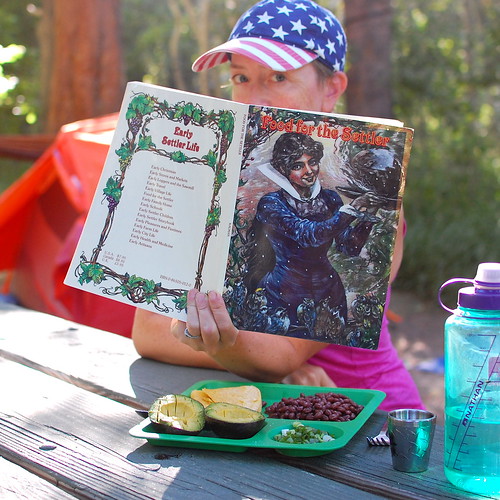
My favorite bits of old-timey stories are descriptions of the meals and medicine. I’m not sure how veracious those descriptions are, but I am ready to believe people drank beer instead of water and starved their fevers. Food for the Settler is a children’s book, so there is no mention of our ancestors' alcoholic tendencies or the more macabre medical procedures. However, I quite enjoyed the descriptions of the settlers’ lives and the recipes.
The book covers every food group (from game to berries to maple syrup), every eating occasion (everyday, “bees,” and holidays), and the tools required (just be glad we have modern kitchens). It includes recipes (adapted to modern ingredients, but, oddly, with all measurements in milliliters) and reproductions of period art (with cheeky commentary).
Some of my favorite tidbits from Food for the Settler:
Children were not allowed to sit at the table! The adults sat and the children stood behind them, holding plates and hoping for scraps. I’m thinking of adopting this tradition next time I have children over for a meal.
Butter was not made by putting cream in a mason jar and passing it from person to person for a shake. (That’s the way we did it in my 4th grade homeroom. Then we spread the butter on Saltines. Delicious.) Okay, I knew old-timey butter was made in a churn, but did you know that the resulting butter is washed with water over and over again until it runs clear? From the pictures in the book, this looks like a huge pain in the ass. Aren’t you glad butter comes in cubes from the store?
The first stoves were very low to accommodate the large cooking vessels settlers already owned for cooking over an open fire. As pots became smaller and lighter, stovetops got higher! I had never even considered that stoves were ever a different height than at present.
I usually read Food for the Settler after dinner, swinging in my hammock, imagining making each of the recipes. As tempting as Stewed Celery with Cream and Bubble and Squeak sound, there is only one recipe that I am seriously considering. Reprinted below, without permission:
Plum Pudding (interestingly, containing no plums)
250 ml light raisins
250 ml dark raisins
500 ml currants
200 ml grated orange and lemon peel
200 ml cooking sherry
250 ml grated carrots
500 ml suet, finely chopped
1.5 L bread crumbs
60 ml flour
300 ml brown sugar
2 ml mace
2 ml nutmeg
5 ml ginger
8 eggs, well beaten
About 4 weeks before Christmas mix the first 4 ingredients together in a bowl. Pour cooking sherry over top of fruit. Let the fruit soak for about 1 week in the sherry. Stir the fruit often during the course of the week. Mix all of the other ingredients together with your fruit. Mix well. Tie the dough into a cloth firmly, but leave enough room for the mixture to swell. Boil it in the cloth for at least 5 hours. Do not let it stop boiling. Store the pudding at least 3 weeks in a cool, dry place to develop full flavor. On Christmas day, steam pudding 30-45 minutes. Serve with hard sauce.
I’m not sure where I’ll find suet or if this recipe will be totally disgusting, but I’m intrigued.
Food for the Settler didn’t give me many ideas for my meals this summer, but it gave me a new appreciation for store-bought food and my camp stove.
As for those old-timey medicines, Bobbie Kalman also wrote Early Health and Medicine (available on Amazon)!
Kalman, B. (1989). Food for the Settler. New York, NY: Crabtree Publishing Company.
3 comments:
Suet is just drippings off meat - sub in any other kind of fat (I know you're vegetarian). A little research tells me that in pre-Victorian times, raisins were called plums.
I love old-timey books like that. We have a funny one about electrical work that notes that a "center light in a bathroom is an abomination."
I found this about Suet on food.com: A form of animal fat, similar to lard, but usually sold in shredded form. Suet is the solid white fat found around the kidneys and loins of beef, sheep and other animals. Traditionally used in British cooking, particularly in dumplings, suet puddings, and some pastries. A vegetable version is now commonly available, made from an oil such as palm oil & usually combined with rice flour, which can be directly substituted for the animal fat version in recipes. I thought you might be interested in the vegetable version since I seem to remember you are a vegetarian. They make it sound like this could be found everywhere, but, an admittedly brief search of Amazon.com only turned up suet for animals. Good luck!
My husband makes plum pudding every year for the holidays! It is a bit of an acquired taste, but if you like the ingredients, you should be fine. I think he has also used brandy instead of sherry for soaking the fruit. And he's even used 'vegetarian' suet - Agora, from the UK - and it turned out fine.
And the hard sauce is important! That creamy butter/sugar blend with the spicey/boozy cake is heavenly! He pours brandy over it and lights it before serving. We all sit in the dark while he carries in the flaming pudding. It's become a fun tradition.
Thanks for the lesson in settler cooking too. I had no idea about the stove heights either!
~J
Post a Comment